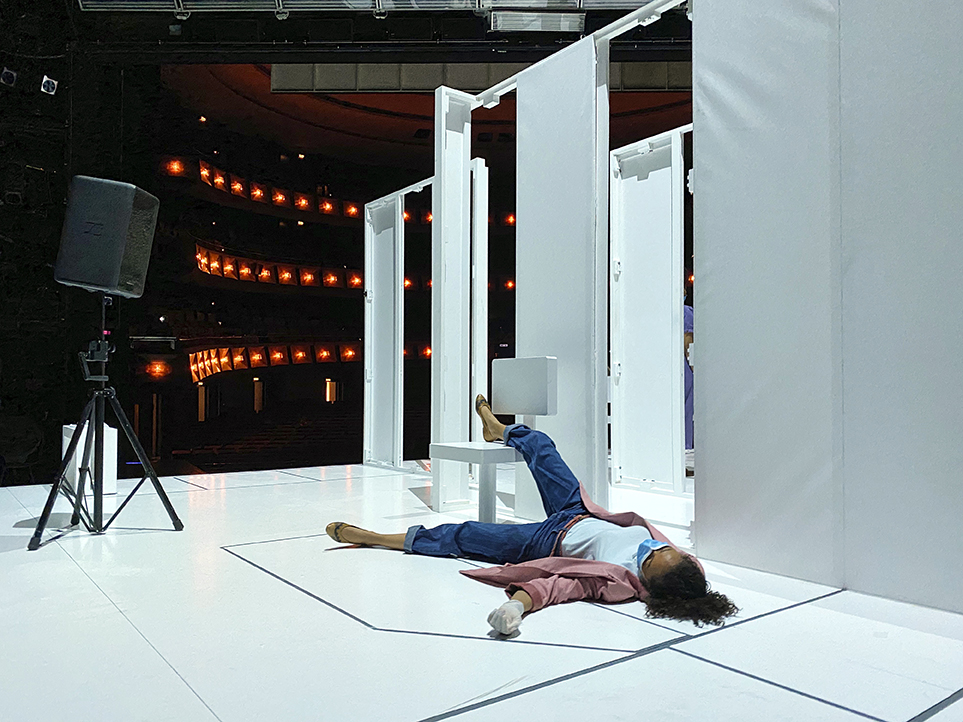 The British-German artist, Tino Sehgal, trains people to carry out instructions conceived by him to create what he calls ‘constructed situations’.
The British-German artist, Tino Sehgal, trains people to carry out instructions conceived by him to create what he calls ‘constructed situations’.
In an interview* he told Hans Ulrich Obrist: “I am not interested in shocking people, but what is interesting for me is that they are astonished not about what this person is doing but that there is a person doing something”.
In the past, I saw a number of Sehgal’s pieces and I have been astonished also by what they are doing. For instance, in the group show, ’11 Rooms’, at the Manchester Art Gallery he created a ‘live’ experience called ‘Ann Lee’. In one of the 11 rooms visitors had to respond to questions posed by an eight year old girl embodying a magna character with a robotic voice. She asked visitors questions that alienated them such as “Would you rather feel too busy or not busy at all?” It caused nervous laughter amongst the visitors who were trying to make eye contact with one another, saying “is this for real?”
For the Tate Modern Turbine Hall commission, Sehgal created another astonishing situation called ‘These Associations’. He trained a group of people to share intimate life stories / experiences with the audience. People shared painful episodes in their lives or life changing events with me. The whole experience was profoundly humane and brought a sense of communion.
Throughout 2015, Sehgal will present each month a work from his oeuvre in a different gallery of the Stedelijk museum in Amsterdam. The first of twelve live-experiences was staged in Room 3, adjacent to rooms that feature works by Braque, Mondrian, Toorop and Breitner – highlights of the permanent collection of the museum. The reason to stage it there is because the work – which is called, ‘Instead of allowing some thing to rise up to your face dancing bruce and dan and other things’ (2000) – was acquired by the museum in 2005.
 In the corner of an empty room a female dancer is lying on the floor slowly moving into various positions. From a fetal position she gradually moves to a yoga stretching position. Every two hours the dancer is replaced by another dancer.
In the corner of an empty room a female dancer is lying on the floor slowly moving into various positions. From a fetal position she gradually moves to a yoga stretching position. Every two hours the dancer is replaced by another dancer.
For art connoisseurs, the title card on the wall offers a clue what the work might be about: the Bruce and Dan makes reference to the work of the artists Bruce Nauman and Dan Graham. For instance, Nauman’s 1968 video work ‘Wall/Floor Positions’ in which the artist transformed himself into a living sculpture investigating space by moving his body in various relations to the wall and floor.
More and more artists are interested in immaterial art including Sehgal. He is not interested to create physical objects. As a former dancer he thought that dance could be an interesting model for his practice which produces no objects but an experience.
To confront the visitors with dance in the museum certainly astonishes them. They are taken by surprise when they first encounter it and try to figure out what the work is about. However, the historical reference in the title seems lost on them. They struggle to relate or engage with the work and stroll to the Mondrian or Breitner in the adjacent rooms. I invested a considerable amount of time in the work, waiting to see if perhaps some kind of transformation would occur. None of that happened, and the question raised with me: is it interesting, exciting to watch?
In terms of the dancing, I can appreciate the dancers’ flowing movements, their concentration and the control of their bodies, but the choreography itself isn’t exciting compared with the works that the Belgian choreographer Anne Teresa De Keersmaeker has performed in museums.
Although Sehgal succeeded in his mission, I’m not convinced by this work. There is no harm in confronting the audience with a person who is doing something interesting – which they do in Sehgal’s later works.
As an introduction, I don’t think the Stedelijk Museum has started their Sehgal year with the strongest work in his groundbreaking oeuvre. Fortunately, there are still 11 opportunities left to astonish the audience all the way.
Written by Thierry Somers
*Hans Ulrich Obrist: Interview mit Tino Sehgal in: Katalog des Kunstpreises der Böttcherstaße Bremen 2003
Upcoming: review of Sehgals’s second installation at the Stedelijk Museum ‘This Is Good’.










